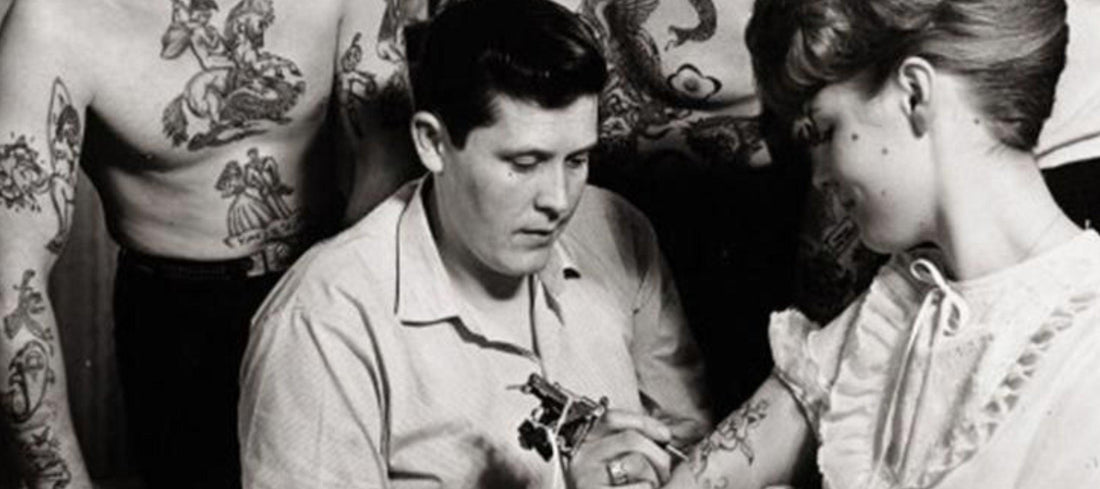On a fall day in 1991, two Germans hiking in the Alps near the Italian - Austrian border stumbled across what they initially believed to be a modern corpse frozen in the ice. Once the body was retrieved however, authorities discovered that it was anything but modern. The mummy, nicknamed Ötzi after the valley where it was found, had survived in the ice to the ripe, old age of 5,300 years. Analysis of the remains showed that when Ötzi died, he was a 30 to 45 year old man, standing roughly 160 cm tall. Mystery surrounds the exact circumstances of Ötzi’s death, although evidence suggests a violent end. That, however, is not the only secret Ötzi hides.
Ötzi has over fifty lines and crosses tattooed onto his body – the earliest known evidence of tattooing in the world - most of them on his spine, knee and ankle joints. The locations of many of the markings are consistent with traditional Chinese acupuncture points, specifically those that are used to treat back pain and stomach upset. What is intriguing is that Ötzi lived roughly 2,000 years before the oldest generally accepted evidence of acupuncture, and well west of its purported origins in China. X-rays revealed that Ötzi had arthritis in his hip joint, knees, ankles and spine; forensic analysis discovered evidence of whipworm eggs - known to cause severe abdominal pain - in Ötzi’s stomach. It is, therefore, possible that Ötzi’s tattoos did in fact play a therapeutic role, and that acupuncture has a slightly more complicated history than previously believed.
Before Ötzi poked his head through the ice, the earliest conclusive evidence of tattoos came from a handful of Egyptian mummies that date to the time of the construction of the great pyramids over 4,000 years ago. Indirect archaeological evidence (i.e. statuettes with engraved designs that are occasionally associated with needles and clay discs containing ochre) suggests that the practice of tattooing may actually be much older and more widespread than the mummies would have us believe.
Ethnographic and historical texts reveal that tattooing has been practiced by just about every human culture in historic times. The ancient Greeks used tattoos from the 5th century on to communicate among spies; later, the Romans marked criminals and slaves with tattoos. In Japan, criminals were tattooed with a single line across their forehead for a first offence; for the second offence an arch was added, and finally, for the third offence, another line was tattooed which completed the symbol for “dog”: the original three strikes and you’re out! Evidence suggests that the Maya, Inca and Aztec used tattooing in rituals, and that the early Britons used tattoos in certain ceremonies. The Danes, Norse and Saxons are known to have tattooed family crests onto their bodies. During the crusades, some Europeans tattooed a cross on their hands or arms to mark their participation and indicate their desire for a Christian burial should they not return.
From the Tahitian “tatau” which means to mark or strike, the word tattoo refers to some of the traditional modes of application where ink is “tapped” into the skin by using sharp sticks or bone. Certain peoples in the Arctic however, have used a needle to pull carbon-embedded thread under the skin to create linear designs. And still others have traditionally cut designs into the skin and then rubbed the incisions with ink or ashes.
Modern electric tattoo machines are modeled on the one patented by New York tattoo artist Samuel O’Reilly in 1891, which itself is only slightly different from Thomas Edison’s electric engraver pen, patented in 1876. The needles of a modern machine move up and down at a rate of between 50- 3000 vibrations per minute; they penetrate only about 1 mm below the surface of the skin to deliver pigments. Our bodies treat the injected pigments as non-toxic foreign elements that need to be contained. So, certain types of cells in our bodies engulf the minute amounts of pigment. Once full, they move poorly and become relatively fixed in the connective tissue of the dermis, which is why tattoo designs do not generally change with time.
A pigment’s molecules are actually colorless. Those molecules though, are arranged into crystals in various ways such that colors are produced when light refracts off of them. The pigments that are used in tattoos are often made of metal salts, which are metals that have reacted with oxygen; this process is called oxidation and is exemplified by rusting iron. The pigment is held in a carrier solution to disinfect the pigments by inhibiting the growth of pathogens, to keep it evenly mixed and to facilitate its application. Most modern pigments are carried by alcohols, specifically methyl or ethyl alcohols, which are the simplest and most commonly used types.
The popularity of tattoos has continuously risen and fallen through time. Currently, the practice of tattooing is booming, and it is estimated that roughly one in every seven people in N. America - over 39 million people total - have at least one tattoo. Through time and around the world, the reasons for getting tattoos are numerous and varied. They include religious purposes, for protection or as a source of power, as an indication of group membership, as a status symbol, as an artistic expression, for permanent cosmetics, and as an adjunct to reconstructive surgery. And now, a new reason can be added to the list: Andrew Fisher, an American webpage designer, recently auctioned his forehead as ad space on eBay. It sold for over $37,000 and left Andrew with a snoring remedy logo tattooed (semi- permanently) on his head for a month. If he weren’t in deep freeze at a museum in Italy, I am sure that Ötzi would be rolling in his grave.

